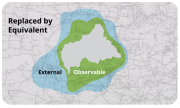 Many utilities and transmission system operators (TSOs) are beset by the difficulty of reconciling and merging a smaller accurate energy management system (EMS) model of the observed network with a larger approximate model of the surrounding “external” interconnected system. Resolving this problem has long been considered the “Holy Grail” of network management. Experts in utilities and TSOs have been searching for decades for an accurate model-merging solution. Until recently, a utility or TSO has had to make assumptions and approximations regarding the external system that compromises its ability to accurately predict network performance and estimate costs—clearly a major concern for utilities and TSOs. Now that new software approaches have arrived to solve this longstanding dilemma, Nexant looks at how utilities and TSOs are poised to deliver improved situational awareness and increased overall reliability.
Many utilities and transmission system operators (TSOs) are beset by the difficulty of reconciling and merging a smaller accurate energy management system (EMS) model of the observed network with a larger approximate model of the surrounding “external” interconnected system. Resolving this problem has long been considered the “Holy Grail” of network management. Experts in utilities and TSOs have been searching for decades for an accurate model-merging solution. Until recently, a utility or TSO has had to make assumptions and approximations regarding the external system that compromises its ability to accurately predict network performance and estimate costs—clearly a major concern for utilities and TSOs. Now that new software approaches have arrived to solve this longstanding dilemma, Nexant looks at how utilities and TSOs are poised to deliver improved situational awareness and increased overall reliability.
Background and requirement
In large pan-European and North American systems, the “internal” system supervised by a modern EMS is typically embedded in a large interconnected system. A state estimator provides a model of the observed network that is accurate and reliable at each instant in time. On its own, however, this “internal” power-system-network model is not adequate for network calculations for near-real time or look-ahead operations planning. This is because the observed network model does not incorporate important external flow-circulation paths and MW/MVAr responses, which have to be derived from non-real-time power-flow models of the large interconnected system.
To enhance the accuracy of the model, portions of the networks adjacent to the internal system often contribute tele-measurements that become included in the state-estimator’s observable model. Figure 1 illustrates an EMS state-estimated observable area connected at boundary nodes to the larger surrounding “external” power system. However, these “small accurate” and “large approximate” network models are rarely compatible and cannot be completely merged to provide a perfectly accurate combined model.
Utilities and TSOs need a reliable network model to perform calculations in near-real time for operational planning and market operation. Such calculations can include power flow, contingency analysis, security dispatch, reactive management, interchange capacity, locational marginal pricing (LMP) and day-ahead commitment. Given that the network model of the observable area is relatively accurate, it is tempting to ignore or crudely approximate the network external to this area. However, this can seriously compromise the validity of the network calculations. To avoid this problem, the best possible model of the external system needs to be attached to the state-estimated snapshot of the observable area without sacrificing any accuracy of the observable-area model.
The compatibility issue
Each available power-flow model of the large interconnected system, in bus-branch form, is assembled centrally once a day at most for a single forecast loading, interchange and topology condition. This external operating state and topology are likely to be very different from that of the actual power system at each execution of the state estimator. The flows, voltages, interchanges, losses and connectivity at the borders of the real-time model may have little in common with those represented in the big-system model. Simple boundary-matching solutions for “attaching” an external model to the real-time model do not work; the accuracy of the “internal” real-time model always ends up corrupted, or the effects of the external system become misrepresented.
Model integration and reduction solutions
Model integration software removes much of the above model incompatibility. These solutions offer rapid production of a solved merged model of a large interconnected system, in which the state of the estimated observable area, normally in bus-section-breaker form, remains accurate. To achieve this “clean fit,” the software adds matching injections at the borders and user-designated external points of generation or load. The software adjusts external generator voltages and interchanges as little as possible and distributes loss differences.
 With model integration software run immediately after each state estimate, it is now possible to obtain a coherent solved model of the entire network that preserves the integrity of the observable model. The EMS can now run its network calculations with greater confidence in its reliability. The solved model can be provided in bus-section-breaker form, bus-branch form, or a combination. Model integration software can run either loosely or tightly integrated in an EMS using an application-programming interface (API).
With model integration software run immediately after each state estimate, it is now possible to obtain a coherent solved model of the entire network that preserves the integrity of the observable model. The EMS can now run its network calculations with greater confidence in its reliability. The solved model can be provided in bus-section-breaker form, bus-branch form, or a combination. Model integration software can run either loosely or tightly integrated in an EMS using an application-programming interface (API).
The integrated model usually will be larger than necessary or desired. In such cases, the electrically remote sections of the network can be replaced with reduced equivalents or even discarded, but this needs to be done very carefully using specialised reduction software packages that produce accurate and well-conditioned equivalent models. In on-line operations, reduction software packages run almost instantly. Off line, the reduction software performs multiple-operating-state sensitivity analysis to determine which elements of a very large network have little effect on the internal area. The results of the reduction analyses are often surprising.
Figure 2 depicts the final network model after model integration and reduction solutions are applied. The state-estimated observable model is surrounded by an external portion representing the given interconnected system model, adjusted to match but not corrupt the observable area. The external portion explicitly models the major generation, loads and transmission elements that can impact the internal area. The large remaining electrically distant part of the network becomes a small equivalent or is discarded.
Model integration and reduction software create an integrated observable and external network model that can produce more accurate and reliable results, giving utilities and TSOs significant confidence in the improvement of network security and market operations.
Result – the Holy Grail of external network management in hand!
With an integrated and observable model, utilities and TSOs are better able to account for external impacts and accurately model the major generation, loads and transmission elements that can impact the internal area. As a result, utilities and TSOs can improve situational awareness and increase reliability.





